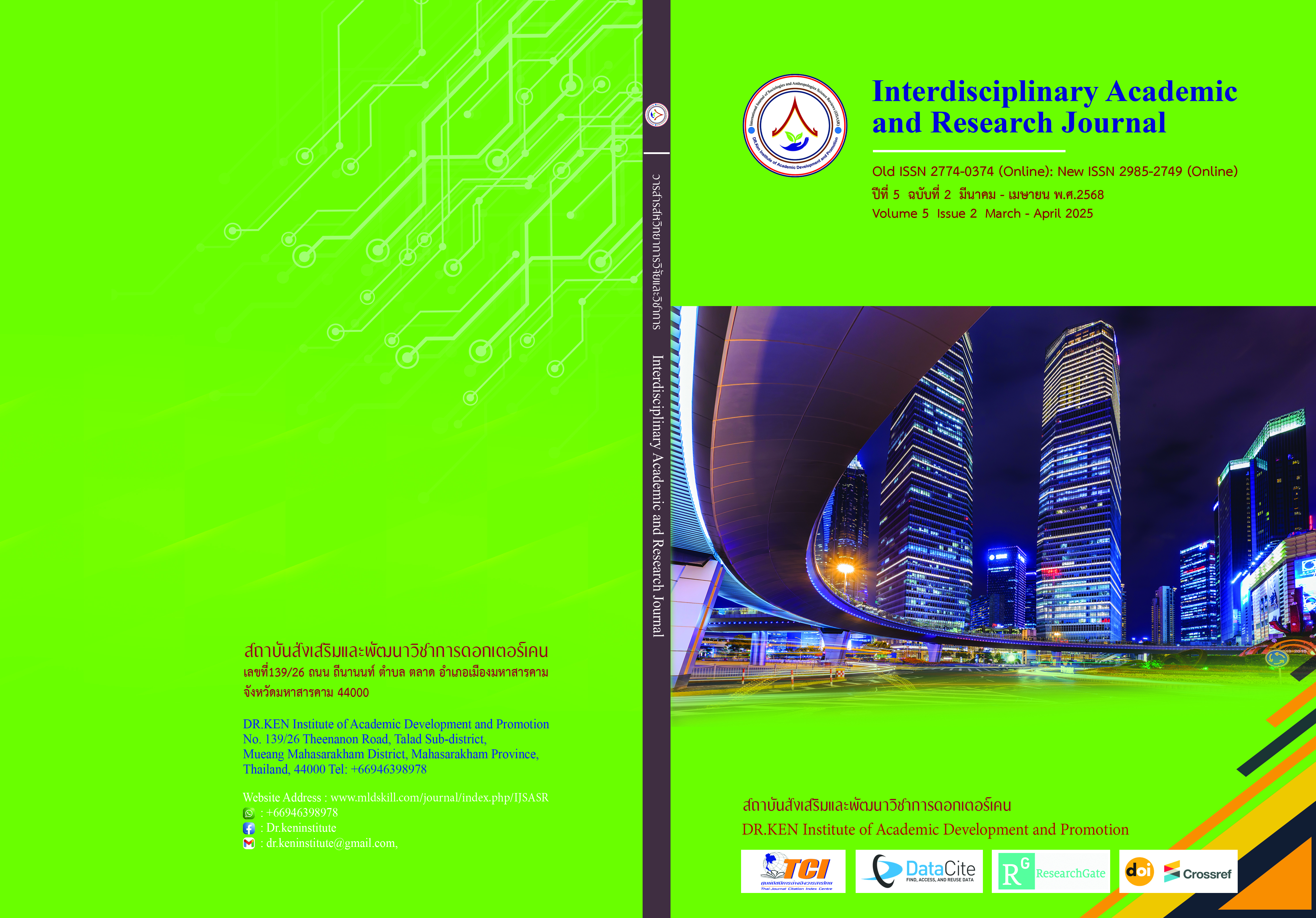ความสามารถในการฟื้นตัวจากการฝึกซ้อมด้วยการเตะเป้า 5 นาที ต่อยกที่ส่งผลต่อการฟื้นตัวของการเตะเป้า 3 นาที ในนักกีฬาปันจักสีลัตทีมชาติไทย
DOI:
https://doi.org/10.60027/iarj.2025.280527คำสำคัญ:
การฟื้นตัว, การเตะเป้า, อัตราการเต้นของหัวใจบทคัดย่อ
ภูมิหลังและวัตถุประสงค์: ความสามารถในการฟื้นตัวจากการฝึกซ้อมถือเป็นสิ่งสำคัญสำหรับนักกีฬา Pencak Silat เพราะช่วยให้พวกเขาพัฒนาประสิทธิภาพ หลีกเลี่ยงการบาดเจ็บ และรักษาสภาพร่างกายให้อยู่ในสภาพที่ดีที่สุดระหว่างการฝึกซ้อมที่เข้มข้น การฟื้นฟูอย่างมีประสิทธิภาพจะช่วยปรับปรุงการซ่อมแซมกล้ามเนื้อ สมาธิ และความยืดหยุ่นโดยรวม ช่วยให้พัฒนาทักษะศิลปะการต่อสู้ได้อย่างสม่ำเสมอ ดังนั้นการวิจัยครั้งนี้มีวัตถุประสงค์เพื่อศึกษาและเปรียบเทียบความสามารถในการฟื้นตัวก่อนและหลังการฝึกซ้อมด้วยการเตะเป้า 5 นาที/ยก ที่ส่งผลต่อการฟื้นตัวของการเตะเป้า 3 นาที/ยก ในนักกีฬาปันจักสีลัตทีมชาติไทย
ระเบียบวิธีการวิจัย: การทดสอบก่อนการฝึกซ้อมด้วยการเตะเป้า 5 นาที/ยก ในนักกีฬาปันจักสีลัตทีมชาติไทยของอาสาสมัครจำนวน 15 คน โดยมีขั้นตอนดังนี้ ให้อาสาสมัครวัดอันตราการเต้นของหัวใจขณะพักก่อนเริ่มการทดสอบการเตะเป้า 3 นาที/ยก พบว่า ค่าเฉลี่ยและส่วนเบี่ยงเบนมาตรฐาน 83± 13.73 bpm และเริ่มการทดสอบก่อนการฝึกซ้อมการเตะเป้า 5 นาที/ยก ด้วยการเตะเป้า 3 นาที/ยก และวัดอันตราการเต้นของหัวใจค่าเฉลี่ยและส่วนเบี่ยงเบนมาตรฐานหลังการเตะทันที 143.13 ± 24.20 bpm วัดอันตราการเต้นเพื่อวัดผลการฟื้นตัวหลังการเตะ 1 นาที ค่าเฉลี่ยและส่วนเบี่ยงเบนมาตรฐาน 104.66 ± 11.43 bpm และเริ่มฝึกซ้อมด้วยการเตะเป้า 5 นาที/ยก ในวันจันทร์วันพุธและวันศุกร์ 3 วันต่อสัปดาห์จำนวน 8 สัปดาห์ เมื่อฝึกซ้อมครบตามกำหนด เริ่มการทดสอบโดยให้อาสาสมัครวัดอันตราการเต้นของหัวใจขณะพักก่อนเริ่มการทดสอบพบว่าอันตราการเต้นของหัวใจขณะพักดีขึ้นกว่าก่อนการฝึกซ้อมด้วยการเตะเป้า 5 นาที/ยก ค่าเฉลี่ยและส่วนเบี่ยงเบนมาตรฐาน 81.66± 12.37 bpm และเริ่มการทดสอบหลังการฝึกซ้อมการเตะเป้า 5 นาที/ยก ด้วยการเตะเป้า 3 นาที/ยก และวัดอันตราการเต้นของหัวใจค่าเฉลี่ยและส่วนเบี่ยงเบนมาตรฐานหลังการเตะทันที 140.24 ± 24.63 bpm วัดอันตราการเต้นเพื่อวัดผลการฟื้นตัวหลังการเตะ 1 นาที ค่าเฉลี่ยและส่วนเบี่ยงเบนมาตรฐาน 101.46 ± 11.02 bpm พบว่าอันตราการเต้นของหัวใจของอาสาสมัครจำนวน 15 คน มีการฟื้นตัวหลังการเตะดีขึ้น
ผลการวิจัย: ผลค่าเฉลี่ยและส่วนเบี่ยงเบนมาตรฐานผลของการศึกษาและเปรียบเทียบความสามารถในการฟื้นตัวก่อนและหลังการฝึกซ้อมด้วยการเตะเป้า 5 นาที/ยก ที่ส่งผลต่อการฟื้นตัวของการเตะเป้า 3 นาที/ยก ในนักกีฬาปันจักสีลัตทีมชาติไทยในกลุ่มตัวอย่างจำนวน 15 คน มีความแตกต่างกันอัตราการฟื้นตัวดีขึ้นระดับความมีนัยสำคัญทางสถิติที่ระดับ.05
บทสรุป: ผลการศึกษาแสดงให้เห็นถึงความแตกต่างอย่างมีนัยสำคัญทางสถิติในอัตราการฟื้นตัวของนักกีฬาปันจักสีลัตก่อนและหลังการฝึกซ้อม โดยการเตะเป้าที่กินเวลานาน 5 นาทีต่อรอบส่งผลต่อการฟื้นตัวในรอบ 3 นาที ซึ่งแสดงให้เห็นว่าความเข้มข้นของการฝึกมีผลที่วัดได้ต่อความสามารถในการฟื้นตัวของนักกีฬา ซึ่งพิสูจน์ได้จากกลุ่มตัวอย่างนักกีฬาทีมชาติไทย 15 คน
References
กัมปนาท แก้วดำรงชัย. (2553). ผลการฝึกความเร็วในการรุก 2 รูปแบบที่มีต่อเวลาตอบสนองของนักกีฬาปันจักสีลัต. วารสารคณะพลศึกษา (มหาวิทยาลัยศรีนครินทรวิโรฒ), 13 (2), 203-214.
ณธพล ทองธนภัทร. (2553). ผลของกิจกรรมสี่แบบที่มีต่อการฟื้นตัวในระยะเวลาจำกัด. วารสารวิชาการ สถาบันการพลศึกษา, 3(1), 131-144.
ประทุม ม่วงมี. (2527). รากฐานทางสรีรวิทยาของการออกกำลังกายและการพลศึกษา. กรุงเทพฯ: บูรพาสาสน์.
มูลนิธิหัวใจแห่งประเทศไทยในพระบรมราชูปถัมภ์ (2560).ออกกำลังกายเน้นสุขภาพหัวใจ ทำอย่างไร. Retrieved from: https://www.thaiheartfound.org/Article/Detail/140292
อรัทยา ถนอมเมฆ. (2555). ผลของความเข้มข้นของเครื่องดื่ม ผสมกลูโคสที่มีต่ออัตราการเต้นของหัวใจ ปริมาณแลคเตทและกลูโคสในเลือด ระยะฟื้นตัวหลังการออกกำลังกายของนักกีฬาหญิง. วิทยานิพนธ์ปรัชญาดุษฎีบัณฑิต, สาขาวิชาวิทยาศาสตร์ การออกกำลังกายและการกีฬา, คณวิทยาศาสตร์การกีฬา, มหาวิทยาลัยบูรพา
อิสริยา ทองห่อ. (2559). ผลของวิธีการฟื้นตัวภายหลังการออกกำลังกายที่มีต่อกรดแลคติกในเลือด อัตราการเต้นของหัวใจและสมรรถภาพเชิงแอนแอโรบิกในนักกีฬา. วิทยานิพนธ์สาขาวิชาวิทยาศาสตร์ (การออกกำลังกายและการกีฬา) คณะวิทยาศาสตร์การกีฬา: มหาวิทยาลัยบูรพา.
Ahmad, M. S., & Salleh, M. S. (2014). The recovery process in combat sports: A focus on Pencak Silat. Journal of Combat Sports and Martial Arts, 5(2), 11-19.
Aziz, A.R., Chia, M., & The, K.C., (2000). The relationship between maximal oxygen uptake and repeated sprint performance indices in field hockey and soccer players. Journal of Sports Medicine and Physical Fitness, 40(3), 195-200.
Barnett, A. (2006). Using recovery modalities between training sessions in elite athletes: Does it help? Sports Medicine, 36(9), 781-796.
Bishop, D., Girard, O., &Mendez-Villanueva, A. (2011). Repeated-sprint ability – part II: Recommendations for training. Journal of Science and Medicine in Sports, 41(9), 741-756.
Dupuy, O., Douzi, W., Theurot, D., Bosquet, L., & Dugué, B. (2018). An evidence-based approach for choosing post-exercise recovery techniques to reduce markers of muscle damage, soreness, fatigue, and inflammation: A systematic review with meta-analysis. Frontiers in Physiology, 9, 403.
Fullagar, H. H., Skorski, S., Duffield, R., Hammes, D., Coutts, A. J., & Meyer, T. (2015). Sleep and athletic performance: The effects of sleep loss on exercise performance, and physiological and cognitive responses to exercise. Sports Medicine, 45(2), 161-186.
McConnell A.K., & Sharpe G.R. (2005). The effect of in-spiratory muscle training upon Maximum lactate steady-state and blood lactate concentration. European Journal of Applied Physiology. 94(3): 277-284.
Phillips, S. M., & Van Loon, L. J. C. (2011). Dietary protein for athletes: From requirements to optimum adaptation. Journal of Sports Sciences, 29(S1), S29-S38.
Quinn, P.C., Uttley, L., Lee, K., Gibson, A., Smith, M., & Slater, A.M., (2008). Infant preference for female faces occurs for same-but, not other-race faces. Journal of Neuropsychology. 2, 15– 26.
Romer, L.M., McConnell, A.K., & Jones, D.A.(2002). Effects of inspiratory muscle training upon recovery time during high intensity, repetitive sprint activity. International Journal of Sports Medicine, 23(5), 353-60.
Stojanovic, M.D., Ostojic, S.M., Calleja-González, J., Milosevic, Z., & Mikic, M. (2012). Correlation between explosive strength, aerobic power and repeated sprint ability in elite basketball players. J Sports Med Phys Fitness. 52(4). 375-381.
Sukpala, T., & Kanungsukkasem, V. (2012). A comparison between interval sprinting and interval sprint cycling on anaerobic and aerobic performance in rugby football players. Journal of Sports Science and Health, 13(2), 33-47.
Downloads
เผยแพร่แล้ว
How to Cite
ฉบับ
บท
License
Copyright (c) 2025 Interdisciplinary Academic and Research Journal

This work is licensed under a Creative Commons Attribution-NonCommercial-NoDerivatives 4.0 International License.
ลิขสิทธิ์ในบทความใดๆ ใน Interdisciplinary Academic and Research Journal ยังคงเป็นของผู้เขียนภายใต้ ภายใต้ Creative Commons Attribution-NonCommercial-NoDerivatives 4.0 International License การอนุญาตให้ใช้ข้อความ เนื้อหา รูปภาพ ฯลฯ ของสิ่งพิมพ์ ผู้ใช้ใดๆ เพื่ออ่าน ดาวน์โหลด คัดลอก แจกจ่าย พิมพ์ ค้นหา หรือลิงก์ไปยังบทความฉบับเต็ม รวบรวมข้อมูลเพื่อจัดทำดัชนี ส่งต่อเป็นข้อมูลไปยังซอฟต์แวร์ หรือใช้เพื่อวัตถุประสงค์ทางกฎหมายอื่นใด แต่ห้ามนำไปใช้ในเชิงพาณิชย์หรือด้วยเจตนาที่จะเป็นประโยชน์ต่อธุรกิจใดๆ














